1.
The concrete walls around me are painted in stale white. I’m sitting on a chair made of cheap wood banded with light metal. The metal parts are coated with glossy, black enamel paint. The chair is chipped in various places that reveal the metal’s dull white-grey colour underneath. I lean heavily on the backrest and two of the chair’s feet rear up creakily from the floor. My right knee is folded on the wooden table in front of me and my chest. I turn right and look out a jalousie window. The glass panes are peppered with fine dust. My view is partly obscured by a mango tree’s branches thick with foliage. From the jalousie window I watch myself standing, slouched, behind a rusting beige gate. The gate’s height goes up to my collarbone. I watch myself peering over it to look out onto the street. I give the street slow, sweeping glances, left to right. I watch myself stare at two vehicles parked in front of the gate. To the right of these vehicles, I see one of my neighbors, a man of about seventy, walking up slowly from the right side of the street and then slowly come to pause on the sidewalk right across the gate. He stares up at the mango tree with a face pale with exhaustion. After several seconds, he drops his head and shambles towards his house in an excruciatingly slow pace. After the pale neighbor is gone, the street is unnervingly still. It has the feeling of a theatre play backdrop after all the actors have left. Silence is seeping into everything like a heavy grey miasma that muffles anything that it touches. I imagine this grey haze and it makes the linings of my lungs itch and the back of my throat taste of bile.
Dusk is sinking into the city like an immense, bruise-colored blanket. I rub my eyes with both hands. I look out again and feel a slight dismay at my blurred vision; my eyes adjust slowly in the fading light. I watch myself open the small door on the left side of the gate and shut it behind me with the latch sounding a small, clean click. With fists clenched, I stand on the sidewalk for a few moments and then begin to head east. A short walk in this direction will take me to small stores selling food and basic goods, a bakery, a moderately expensive hardware store, a barbershop. Walking further will take me to several grocery stores and a wet market. I think of the barber shop and remember that it has been years since I have gone there for a haircut. These days I cut my own hair because this avoids the awkward conversation with the barber on what kind of haircut I want. It always seemed like I had a vague idea of what I’d want for a haircut, but I’d forget what it was once I reached the barbershop. And so I’d say to the barber, to get it over with quickly as possible, It’s up to you. Just cut it short and make it quick. And he would shear everything off as quickly as he could so that he could get to his next customer. I’d always feel a mild regret while looking in the mirror as I brushed clumps of hair off my shoulders and hurriedly paid the barber with crumpled bills from my pocket, all the while thinking that I should have been more decisive about what my head should look like. When I got home, I’d take a look at my head again in a mirror and would see that beads of blood that formed around my shaved temples from the hurried but forceful strokes of the barber’s razor. While thinking about the barber, I lose sight of me. The last glimpses I catch of myself are through a sickly looking tree to the right of our gate. The tree has branches that are like gnarled, rheumatic fingers sprouting small purple leaves. I have known this tree since I was a child and have always thought it looked like a pale, withered old man standing stiff and crooked in the corner by the gate. The image of that pale old man stands silently beside me as I write this. His eyes are tightly shut and his hands are crushed into quaking fists, seemingly in great frustration or rage. Now out of sight, I imagine myself walking, making my way east. I am now passing the moderately expensive hardware store. I adjust my face and continue walking towards the grocery store and the wet market. I take a deep breath. Areas beyond the hardware store have begun to make me nervous. Clusters of faceless men in camouflage now set in these places. The other day I saw one of these camouflaged men shout threats of violence at a line of cowed people. I promptly lined up with the people while I nervously watched the men fingering their guns. I hope that the shouting never turns into shooting. (As I write this now, I know that eventually it will.) As I watched these faceless men shouting, the word dehumanizing came to mind.
[It comes to mind through your front door and leaves it ajar. It settles down on your couch with a relieved sigh and opens a newspaper. The way its face looks as it reads with the corner of its lips downturned, it seems to be smugly reveling in a recent achievement. It has entered your space with an ease, as if it has done this countless times before (maybe because it has.) It gracefully lifts its legs and places them on your low table, one leg on top of the other. It continues to read the newspaper with its eyes squinted, head tilted upward and lips still turned downward. Feeling nervous and confused, from a corner in the room you’re thinking, Who is that? And why are it’s feet so dirty? I don’t want it trailing dirt in here…But it will leave dirt. Staring closely, the dirt caked beneath its shoes seems to be a very deep maroon verging on black, rather than the simple brown of mud or soil. Just by looking at it you can somehow tell that the dark dirt will stain like blood on teeth. Now it’s reaching for your cup of coffee on the low table and sips it loudly and with pleasure. It savours the hot black liquid from your mug. Time passes. It feels like hours or possibly days or weeks. You can’t tell anymore — time has taken on a peculiar quality and has become slippery, like attempting to grasp a slick but scaly medium-sized fish thrashing in your hands.Finishing your coffee, it takes its feet off your table and folds its newspaper neatly and sets it squarely on the table. It opens its mouth wide, wider than you thought a mouth could (and should), and yawns deeply. But it doesn’t stand up to leave as you’re hoping it would. Around its feet, hidden by your low table, it picks up a suitcase made of leather, aged and tanned a deep brown from frequent use, from your floor and opens it on its lap. The two metal clasps on the suitcase open with simultaneous, satisfying clicks. It takes out a number of objects from its suitcase and lays them around your low table. To make more spaces for its things, it takes down your personal belongings from the table: a small green notebook, a stack of family photographs, a small marble turtle figurine, a square, jade-green paperweight sculpted in ceramic with a relief of stylized people who are holding each other together through their linking of arms, once given to you by your uncle. They may seem of small value at first glance, but each one is of great value to you. It tosses them down to the floor. that may seem of small value at first glance, but are of great value to you, and it tosses them down to the floor. You feel offended as your possessions are carelessly removed from their usual places but somehow don’t make a move to stop it. The marble turtle’s head snaps off as it lands neck first on the floor. Ah…They’re not supposed to be handled that way, you think meekly. It slowly turns its head to you, as if it has just noticed that you were there this whole time. Seemingly far from finished from unpacking its things, it looks at you with an eyebrow raised in mild surprise and then its eyes quickly and sharply narrow as they move over you. While it looks, you can’t help but squint and wince glancing toward the window to your right, to avoid its gaze. A sour drop of sweat painfully streaks down into your eye as you rigidly watch motes of dust floating in the yellow streaks of sunlight coming through the window. Its head quickly flicks back to the open suitcase on its lap, apparently finding something more worthwhile in the suitcase compared to the effort of regarding you. With its focus on whatever is still in the suitcase, it says to you with disconcerting unabashedness, You don’t mind. I’m staying here for a while — for a long while, as long as I’d like. Don’t know until when… And also, having some others over. They’ll settle in as I have. I know you don’t mind. No, you don’t mind — you don’t, no. They’ll make their way here soon enough, soon enough, soon. As soon as the last syllable drops from its mouth, it seems to forget that you were there at all. You don’t matter at all it seems to be exclaiming just with its presence, the wordsit seems to be leaking inexorably from its being. You throw a nervous glance at the front door that’s still hanging ajar. Standing in your corner, you are sure of nothing apart from being unsure. You stand frozen and hapless, yet something inside you knows you should be showing an effort to address whatever is happening. You take a deep breath and you consider what to do. A considerable amount of time (you can’t tell anymore) passes while you think. Motes of dust continue to float lazily by the window.
As you stand there, a black, viscous substance, not unlike tar, blood or molasses, begins to flow and pool underneath your couch. Smug voices from the direction of the couch, rudely cut into your reverie, sounding like they come from mouths lined with razors: Good luck getting that stain out. Look! It’s spreading — What’s that pattern it’s making? Is that a tree or a house fire? A bruise blooming on flesh? A dry rattling lung? I can see someone — what is he doing — pleading? Reasoning? Oh…he might as well wish he was…]

About the Author
Remaining anonymous for reasons of safety, an Unnamed Artist lives and works on the archipelago known as the Philippines where they regularly contribute to events and activities as an independent artist.



